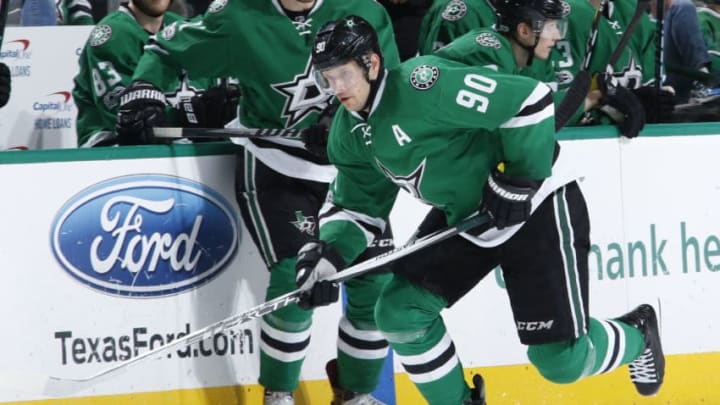With Jason Spezza most likely headed to the wing on the Dallas Stars’ second line, the career-long center will need to adjust. However, there’s no need for concern.
Over the past two seasons, the former head coach of the Dallas Stars, Lindy Ruff, has experimented by putting a veteran of 911 National Hockey League games on the wing. That veteran is Jason Spezza, whose time alongside Mattias Janmark and Radek Faksa on the right side has been a bit rocky.
Spezza has made his money, figuratively and literally, by playing down the middle. A nearly point-per-game player from his rookie season with Ottawa to now, Spezza is signed for two more seasons at $7.5 million annually, but he’ll now be making that cash on the wing, it appears. The Dallas Stars organization indicated that the signing of established two-way forward Martin Hanzal was as a second-line center.
With a rumored top trio of Jamie Benn, Tyler Seguin, and Alexander Radulov, there’s only one spot for Jason Spezza in the Stars’ top six: second-line right wing. Janmark or Brett Ritchie will likely be on the opposite side of Hanzal, but Spezza will almost certainly be forced to play the right side.
But how does Spezza perform on the wing? Should we be concerned? Using data from Left Wing Lock, a comprehensive hockey stat database and tool website, I quickly answer these questions with a “well” for the former and a “no” for the latter. In fact, half of the most effective lines with Spezza featured the Mississauga native playing right wing.
More from Blackout Dallas
- Dallas Stars Traverse City Tournament: Who had great performances?
- Grushnikov and Stankoven lead Dallas Stars to 6-3 win over Columbus
- Dallas Stars prospects look to wrap up tournament with a win
- Burn the tapes: Dallas Stars prospects lose 5-1 to Toronto Maple Leafs
- Dallas Stars look to continue success today against the Maple Leafs
While the most frequent line for Jason Spezza had the four-time 80-point scorer in the middle of Benn and Seguin (usage rate of 23.1%), the supernova line boasted an above-average but relatively underwhelming Corsi For Percentage of 51%. Compared to when Spezza played with Faksa and Antoine Roussel, a line on which he played right wing for nearly 7% of all of his 1,100 minutes in the 2016-17 season, with a CF% of 59.9%.
Nearly 60% of all shots taken by each team while the line of Roussel, Faksa, and Spezza were from the Dallas Stars. Scoring chances and, of course, goals scored obviously increase when the majority of total shot attempts taken are in favor of your club.
The Roussel-Faksa-Spezza line posted an overall save percentage of .909, which was second-best among Spezza line combinations. 21-12-90 was able to generate offense and still get back into their own zone and help out defensively well, which is another reason as to why there shouldn’t be concern for Spezza on the wing.
Spezza, last season, was rather slow in adjusting to the small, simple aspects of the playing the wing as opposed to center: different face-off responsibilities, defensive strategy, and a contrast in puck possession time. However, as Spezza, 34, begins to fall out of his prime, he might be suited better to play on the wing.
Related Story: Dallas Stars Must Move One Center To Right Wing
Jason Spezza, so to speak, will never go down as the best defensive center ever. Not in the past six seasons has Spezza began more of his shifts in the defensive zone, posting an overall offensive zone start percentage (oZS%) of 55.7%. Playing the wing gives him a better opportunity, especially under a head coach like Ken Hitchcock who plays a heavily “centerman back, wingers forward” system, to gravitate towards the offensive zone and utilize the ridiculous offensive skills he possesses.
Playing with a defensive center like big, bruising Martin Hanzal – whose 6’6″ frame and face-off win percentage of 57% over the past four seasons bring loads of value to the Dallas Stars – will help Spezza get the hang of the wing and further refine his game on that side. With Hanzal holding down the fort in the defensive zone, Spezza can torch opposing defensemen offensively.
Next: Short-Sighted Stars Roster Prediction Goes Under The Knife
Spezza’s 6’3″ and 205-pound frame will become even harder to defend when he’s squeezing around the boards, as well. With the size to get around opponents and the hands to completely mystify them, Spezza will arguably be even more dangerous as a Dallas Stars winger. Additionally, it fills an organizational void at right wing left by the departures of Patrick Sharp, Patrick Eaves, and Ales Hemsky.
Now, one more thing: Is it October yet?
